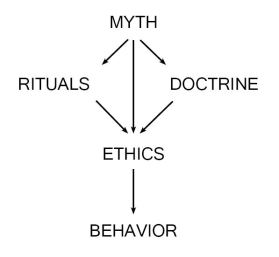Public interest designers have become more global, resulting in interacting with cultures and communities very different from their own. Sometimes this results in ethical dilemmas, designers misunderstanding or misinterpreting cultural traditions, morals, and behavior of the communities they are designing for.
A recent theory, the Moral Foundations Theory, provides a set of foundational ideas that generally guide people’s judgement about right or wrong. These points include:
- Care/harm
- Fairness/ Cheating
- Loyalty/ Betrayal
- Authority/ Subversion
- Sanctity/ Degradation
People/ governments/ communities look to each of these things to determine what they believe is right or wrong and how they value things.
I have heard many times that architecture school teaches its students how to think. I believe this is a great attribute for designers. Thinking enables us to look deeper into the why behind the what. The why, as found in many cases, usually begins with a story or a myth.
For example, in ancient Hindu culture, when a man died, he was 
burned on a funeral pyre and, if he was married, his wife was thrown on thepyre to be burned alive. Now many think that this is crazy, but the Hindus are channeling a myth, the myth of the goddess Sati, who honored her husband after his death by burning herself.
Because we know the story, we know the why behind the what.
The ethic s of a culture stem from a myth, according to Ninian Smart, who created a model for identifying religions (and in our case of designing for cultures). A myth is explained by rituals and doctrine, which explain the ethics, and therefore the behavior of a culture.
s of a culture stem from a myth, according to Ninian Smart, who created a model for identifying religions (and in our case of designing for cultures). A myth is explained by rituals and doctrine, which explain the ethics, and therefore the behavior of a culture.
In order for public interest designers to avoid the misunderstanding and the enforcing their own beliefs on a culture, they should look for the myth in the culture they are designing for, so they can show their solidarity with the community through the design.

